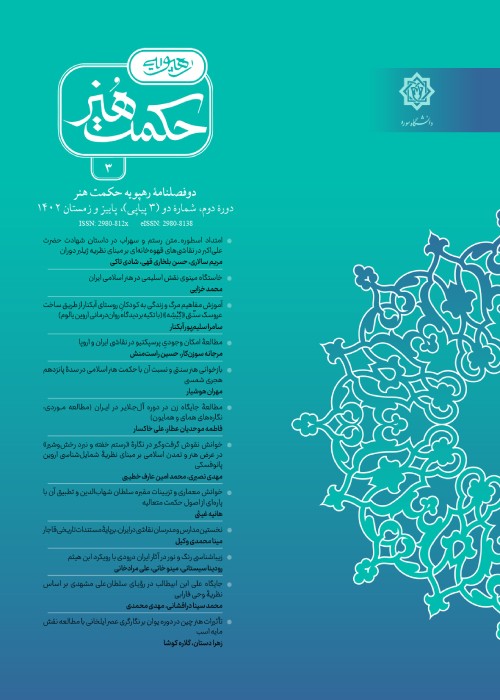The Role of Illustrated Persian Khamsa in the Three-Step Production of the Repeated Patterns Relied on 'Recognition' in Islamic Optics
Based on Ibn al-Haytham's theories, especially the recognition in the second part, third chapter in al-Manazir (book of optics), the visual signs/codes (al-amarat in Arabic) are the most effective visual elements through the perception process of seen images. Perception power of human beings compares the specific signs of the observed objects or scenes with the forms that have been seen and saved in the memory before and via this process it is able to recognize. While Ibn al-Haytham's idea published more than ten centuries before (1011-1021 AD), modern science verifies the role of the signs and recognition in the perception process. Therefore, several art theorists described the process of understanding the artistic works relied on these concepts. They explained that if a viewer's the mental visual codes math the visual forms/signs in an artwork, the viewer will be able to decipher the artwork and will understand it. In this article, I emphasize to both Islamic optics theories and the modern art theorists' interpretations, and demonstrate the role of the repeated patterns as the visual signs in Persian paintings. These patterns both caused to survive a collection of the standard forms and facilitated the viewers' perception process. These repeated patterns were produced in a three-step process: first, production/selection; second, consolidation; third, transfer and continuity. Due to the importance and necessity of repetition to do both process (i.e., the perception process and the three-step process), the illustrated Persian manuscript that used to be duplicated frequently played the important role. Nizami's Khamsah (means quintet or five treasures) was one of them. This book contains five poems in one of which is narrated the love story of Khosrow and Shirin. A part of this story in which was depicted bathing Shirin used to paint in the most illustrated Khamsah from 14th century. Since the narration emphasizes to Khosrow's surprise after looking at beautiful Shirin, the Persian artists used to present Khosrow whom put his index finger on his lips. This posture as a repeated pattern shows a Persian phrase that means being surprised. In this article, I traced the repeated pattern in 25 illustrated Khamsah manuscripts in which were painted bathing Shirin. These manuscripts are in the famous libraries and museums around the world, such as the British library, the national library of France, the Walters art museum, the metropolitan museum, Etc. Analyzing Khamsahs' illustrations provides that in the two pioneering illustrated Khamsahs (in 1365 and 1386-88 AD) the index-finger-on-the-lip pattern was painted to show being surprised in bathing Shirin scenes for the first time. Therefore, the dual relationship of the pattern/concept appeared in the ancient viewers' mind. Since 15th century, the pattern was frequently painted in the bathing Shirin to consolidate the pattern/concept. Since the mid of 15th century, in addition to repeat the pattern in bathing Shirin scenes, the index-finger-on-the-lip patterns were painted in the diverse scenes in other stories to transfer and spread. After this time, the index-finger-on-the-lip patterns used to show being surprised in whole scenes or stories. Achieving this article, Khamsah as a frequent and popular story was duplicated and illustrated repeatedly. Because of this, these manuscripts have the important roles in the three step production of the repeated patterns.
- حق عضویت دریافتی صرف حمایت از نشریات عضو و نگهداری، تکمیل و توسعه مگیران میشود.
- پرداخت حق اشتراک و دانلود مقالات اجازه بازنشر آن در سایر رسانههای چاپی و دیجیتال را به کاربر نمیدهد.



